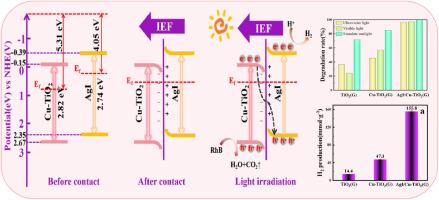Enhanced photocatalytic performance of gully-like AgI/Cu–TiO2 composites with synergistic effects of phase junction and S-scheme heterojunction
IF 4.9
3区 材料科学
Q2 CHEMISTRY, MULTIDISCIPLINARY
引用次数: 0
Abstract
Using polystyrene (PS) spheres as templates, Cu–TiO2(G) photocatalysts with gully structures were prepared by the sol–gel and ion doping method. AgI/Cu–TiO2(G) composites were then successfully prepared via AgI nanoparticles depositing on Cu–TiO2(G) composites in situ. The characterization results show that the composite material presents uneven gully morphology, and gully widths is uniform and neatly arranged. Cu doping and AgI loading cooperatively improve the visible light absorption of AgI/Cu–TiO2(G) composite and reduce the band gap energy of the material. In addition, in AgI/Cu–TiO2(G) composites, anatase TiO2 forms phase junctions and heterojunctions with rutile TiO2 and AgI, respectively, which improve the separation and migration efficiency of photogenerated carriers. AgI/Cu–TiO2(G) composites exhibit excellent photocatalytic activity in the multi-mode photocatalytic degradation reaction. Meanwhile, this composite material demonstrates a higher catalytic activity in the photocatalytic water decomposition for hydrogen production experiments under simulated sunlight irradiation, and its hydrogen production rate is approximately 10.8 times that of pure TiO2. The charge separation efficiency is enhanced because the S-scheme heterojunction is constructed between AgI and TiO2, and the homojunction is formed between the anatase and rutile phases of TiO2, which further improving the photocatalytic performance.

相结和s型异质结的协同作用增强了沟槽型AgI/ Cu-TiO2复合材料的光催化性能
以聚苯乙烯(PS)球为模板,采用溶胶-凝胶和离子掺杂法制备了沟槽结构的Cu-TiO2 (G)光催化剂。将AgI纳米颗粒原位沉积在Cu-TiO2 (G)复合材料上,成功制备了AgI/ Cu-TiO2 (G)复合材料。表征结果表明,复合材料沟壑形态不均匀,沟壑宽度均匀、排列整齐。Cu掺杂和AgI负载共同提高了AgI/Cu - tio2 (G)复合材料的可见光吸收,降低了材料的带隙能。此外,在AgI/ Cu-TiO2 (G)复合材料中,锐钛矿型TiO2分别与金红石型TiO2和AgI形成相结和异质结,提高了光生载体的分离和迁移效率。AgI/ Cu-TiO2 (G)复合材料在多模式光催化降解反应中表现出优异的光催化活性。同时,该复合材料在模拟阳光照射下的光催化水分解制氢实验中表现出更高的催化活性,其制氢速率约为纯TiO2的10.8倍。由于在AgI和TiO2之间构建了s型异质结,在TiO2的锐钛矿相和金红石相之间形成了同相结,从而提高了电荷分离效率,进一步提高了光催化性能。
本文章由计算机程序翻译,如有差异,请以英文原文为准。
求助全文
约1分钟内获得全文
求助全文
来源期刊
CiteScore
7.80
自引率
2.50%
发文量
605
审稿时长
40 days
期刊介绍:
The Journal of Physics and Chemistry of Solids is a well-established international medium for publication of archival research in condensed matter and materials sciences. Areas of interest broadly include experimental and theoretical research on electronic, magnetic, spectroscopic and structural properties as well as the statistical mechanics and thermodynamics of materials. The focus is on gaining physical and chemical insight into the properties and potential applications of condensed matter systems.
Within the broad scope of the journal, beyond regular contributions, the editors have identified submissions in the following areas of physics and chemistry of solids to be of special current interest to the journal:
Low-dimensional systems
Exotic states of quantum electron matter including topological phases
Energy conversion and storage
Interfaces, nanoparticles and catalysts.

 求助内容:
求助内容: 应助结果提醒方式:
应助结果提醒方式:


